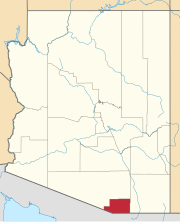Lochiel, Arizona
Lochiel, Arizona | ||
|---|---|---|
FIPS code 04-41750 | | |
| GNIS feature ID | 31163 | |
Lochiel is a populated place and former border crossing in southern Santa Cruz County, Arizona, United States, approximately 25 miles east of Nogales. Basically a ghost town, the townsite is located in the southwestern part of the San Rafael Valley on Washington Gulch, about 1.5 miles west of the Santa Cruz River.[2] It was first settled in the late-1870s and mostly abandoned by 1986.[3][4] The town served the ranches of the San Rafael Valley and the Washington Camp and Duquesne mining towns of the Patagonia Mountains, approximately five miles to the northwest up Washington Gulch.[2]
Name
The present-day Lochiel was originally known by local Mexican settlers as La Noria, which is Spanish for a wheel-drawn well, and later as Luttrell, before being renamed "Lochiel" by the rancher Colin Cameron in 1884.[4][5]
Lochiel is the main branch of
History
The Lochiel area was originally inhabited by a small community of Mexican ranchers before a smelting works was erected in the late 1870s to serve the nearby mines in the Patagonia Mountains, bringing in American settlers. By 1881, a town by the name of Luttrell had formed and was home to some 400 people, most of whom worked in the smelter or in the mines, as well as five stores, three saloons, a brewery, a butcher shop, a bakery, livery stables, and a boarding house operated by Dr. James Monroe Luttrell, for whom the town was originally named.[4][5]
In 1884 the cattle baron Colin Cameron established the San Rafael Ranch about a mile north of Luttrell. That same year he managed to have the postmaster in town rename it "Lochiel", after his homeland back in Scotland. Several years after that, the international boundary between Sonora and Arizona was surveyed and it was found that half of the settlement was in Mexican territory. The town was then split in two. La Noria became the name of the Mexican part of town while the American side continued to be known as Lochiel.[4][5]
In the early 1910s,
A few people still live in Lochiel to this day. In addition to a collection of old houses, Lochiel is the site of an
Gallery
-
The U.S. Customs station.
-
The one-room schoolhouse, built sometime before 1905.
-
The teacherage next to the schoolhouse.
-
An old adobe church.
-
The Sunwest Ranch House in Lochiel.
-
The monument to Fray Marcos de Niza, the first European west of the Rocky Mountains.
See also
References
- ^ "Feature Detail Report for: Lochiel". Geographic Names Information System. United States Geological Survey, United States Department of the Interior.
- ^ a b Nogales, Arizona, 30x60 Minute Topographic Quadrangle, USGS, 1994
- ISBN 978-1930193284.
- ^ ISBN 0806108436.
- ^ ISBN 0979026105.
- ^ Fraser-Mackintosh, C. (1888). The Celtic Magazine: A Monthly Periodical Devoted to the Literature, History, Antiquities, Folk-lore, Traditions, and the Social and Material Interests of the Celt at Home and Abroad, Volume 13. A. & W. Mackenzie. pp. 466–7.
- ISBN 0816522871.
- ^ "Arizona State Parks: San Rafael Ranch". Archived from the original on December 27, 2014. Retrieved December 10, 2014.
- LCCN 79-91724.
- ^ "Archaeology Southwest: Descriptions of Important Historic Sites" (PDF). Archaeology Southwest. Retrieved February 16, 2015.
External links
- Lochiel or Luttrell or La Noria – ghosttowns.com
 Media related to Lochiel, Arizona at Wikimedia Commons
Media related to Lochiel, Arizona at Wikimedia Commons Ghost towns travel guide from Wikivoyage
Ghost towns travel guide from Wikivoyage







